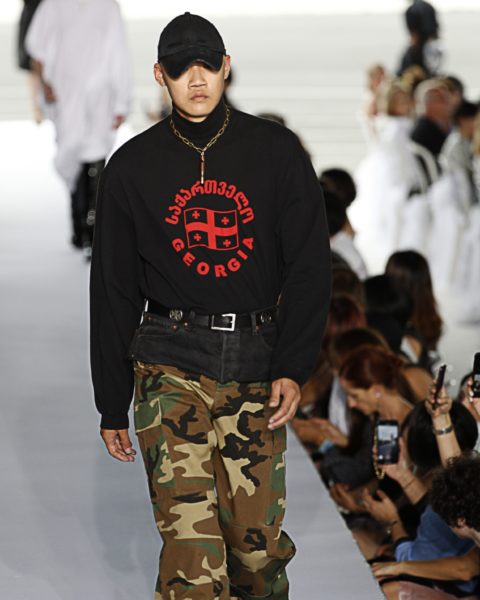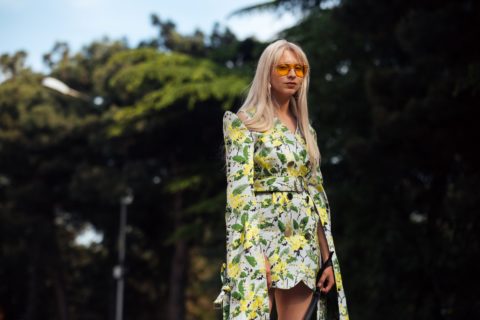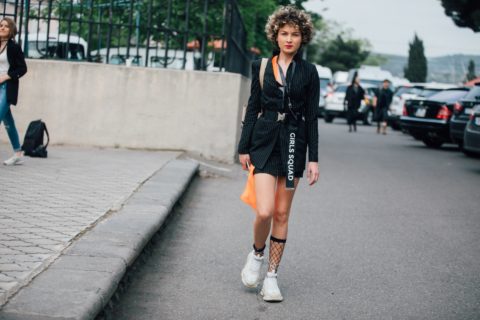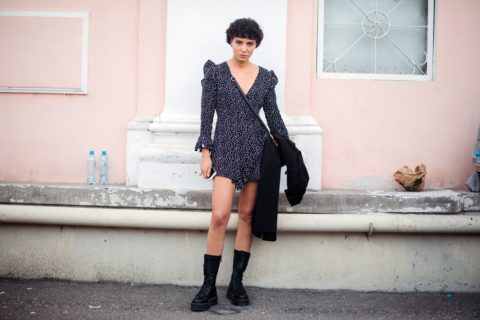Why There’s More to Georgian Fashion Than Just ‘Post-Soviet’ Style
For years, Georgia has been the subject of breathless think pieces trumpeting its status as a burgeoning fashion capital. Georgia’s capital Tbilisi has been dubbed an “emerging fashion capital,” the “next fashion hotspot,” and “the world’s most exciting fashion destination.” The country was the ‘guest nation’ at the insider-y menswear tradeshow Pitti Uomo in Florence earlier this year, not to mention Georgia was a core reference in Demna Gvasalia’s Spring 2019 Vetements collection, which plumbed the depths of his childhood trauma caused by living in the midst of the Georgian civil war to create a dark pulsating collection full of combat fatigues, fringed babushka scarves and tourist t-shirts spelling out ‘clothing’ in Georgian script, Vetements clever version of a logo t-shirt.

While it’s clear that Georgia’s popularity as an object of fascination for Westerners isn’t flagging (the country hosted four million visitors in the first seven months of 2017 alone), part of Georgia’s appeal comes from a fundamental misunderstanding of the country. Western journalists often position Georgia as a wholly unique country based on its geographic proximity to Russia, Europe and the Middle East, and Soviet history, which motions uncomfortably towards Darwin’s theory of divergent evolution. In the Galapagos, Darwin discovered that finches who shared a common ancestor developed completely different traits based on what they had to eat and where they lived. Similarly, because Georgia occupied by the Soviet Union from 1922 to 1991, there’s an underlying assumption that the fresh perspective of Georgian fashion evolved due to total cultural isolation.
Irakli Rusadze, the designer behind Situationist, one of the brands that’s seen as leading the Georgian fashion pack laments via e-mail that most of Western coverage of the Georgia tends to contextualize Georgia as a post-Soviet country as if that alone explains why the country is so full of creativity. “Georgian history is so much deeper and interesting than 70 years of the last century,” he writes.

Emphasizing Georgia’s association to Russia is a particularly sensitive subject considering 20% of Georgia is still under Russian occupation. Many of the citizens of disputed territory Abkhazia have been displaced from their homes and are referred to as “the Lost Generation.” Still, “Georgia is a magical country with strong heritage,” says Irma Shakiradze of Irma de Flore, who designed a headpiece worn by Bjork at the superstar’s concert in Tbilisi. Shakiradze finds her design inspiration in “Cacausus history” which goes back as far as Jason and the Argonauts, who traveled to Georgia’s second-largest city, Kutaisi, on their journey to find the golden fleece; Queen Tamar, Georgia’s powerful female ruler who took on the mantle of ‘king” during her reign in the Medieval era; and Shota Rustaveli, the Georgian poet after whom the main thoroughfare in Tbilisi is named after.
Tbilisi is a vibrant city in varying stages of decay and renewal. On the edges of the city there are apartment building painted ice cream cone pastel. Paint and plaster peels off the facades of stunning 18th century buildings, and intricate wrought iron balconies are rusted through. The smell of cat urine mingles with baking bread. Tbilisi didn’t strike me as any more or less stylish than any other city I’ve visited, but it was suffused with a quivering creative energy that gave me the sense that anything is possible.
Designer Anouki Areshidze finds inspiration in Georgia’s lush landscapes. “Living in Georgia…travelling around the country, and seeing beautiful nature, the lands lays on your mind and sooner or later they will be expressed in the collections I make in a different way,” she writes over email.

Tamara Kopaliani is the only Georgian designer I seek out who links her designs to her post-Soviet past. “When I was growing up, Georgia was one of the gloomiest places – we were in ruins – no electricity, no heating, hunger…But even in the worst times, I could not identify myself with this gloom. I suspect that my infatuation with bright colors, expressiveness, [and] radical ideas stems from countering that feeling of despair.” Kopaliani says the bold colours and textures she uses to create her collection is similar to the way she describes Tbilisi; a “chaotic mix of ancient ornate and dilapidated houses next to Stalin era power-projecting Soviet constructions and new shiny glass buildings.”
It will be fascinating to see if Georgia’s cultural currency in the fashion world will be longstanding or last only as long as Demna Gvasalia’s notoriety. It has been considered “emerging” for years now, a polite way of saying there is heightened interest but it hasn’t quite arrived. It’s rather awkwardly teetering on the precipice between emerging and established, ready to topple in one of the two directions. Either way, you can only stay nascent for so long.
Fashion may be the hottest cultural export that Georgia has going at this time but in the country itself, its more of a subculture than a national pastime, albeit one with outsize influence. But like the Japanese avant-garde designers of the 1980s or the Antwerp Six , sometimes a small group of rebels is all you need to make an impression.








